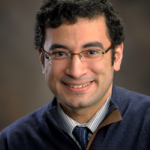The 2023 Kahramanmaras Earthquake Sequence in Turkey: Relations to California Earthquakes, Ground Motion, and Seismic Risk
The 2023 Kahramanmaras earthquake sequence: On February 6, 2023, at 04:17 TRT (01:17 UTC), a devastating earthquake with a magnitude Mw 7.8 struck southern and central Turkey near the border with Syria1. Just a few hours later, another earthquake with a magnitude Mw 7.5 followed at 13:24 TRT (10:24 UTC), centered 95 km (59 mi) north-northeast from the first2. The seismic sequence resulted from shallow strike-slip faulting and led to widespread damage and tens of thousands of fatalities in Turkey and Syria. The Mw 7.8 Pazarcik earthquake was one of the strongest ever recorded in the region and its intensity was felt in multiple countries3. The two large events and their numerous aftershocks are referred to as the Kahramanmaras earthquake sequence. As of March, 20, 2023, the earthquakes had caused over 50,000 fatalities in Turkey and over 7,200 in Syria. According to several reports, more than 164,000 buildings were either destroyed or severely damaged4 and nearly 150,000 commercial structures were at least moderately damaged5. It is estimated that about 2.7 million people in Turkey6 and 5.4 million people in Syria7 were made homeless. The economic losses from the earthquakes are estimated so far to be US$104 billion in Turkey (~13% of the national GDP)8 and US$5.1 billion in Syria (~50% of the national GDP)9. This makes the Kahramanmaras sequence the fourth costliest on record after the 2011 Tohoku earthquake and Tsunami, the 1995 Great Hanshin earthquake, and the 2008 Sichuan earthquake10.
The M7.8 Pazarcik earthquake was, by many measures, bigger and more destructive than what had been expected based on historical records and the tectonic setting. Although the East Anatolian Fault (EAF) has produced large or damaging earthquakes in the past few hundred years on its various segments (Figure 1), none of these events came close to the magnitude of the Pazarcik earthquake. These historical events include the 1789 (M 7.2, Palu), 1795 (M 7.0, Pazarcık), 1872 (M 7.2, Amanos), 1874 (M 7.1, Palu), 1875 (M 6.7, Palu), 1893 (M 7.1, Erkenek), 1971 (M6.6, Karlıova) and 2020 (Mw 6.8, Pütürge) earthquakes11. Each of these events ruptured a segment of the EAF but none was extended over multiple segments as the recent event. Understanding how it was possible for the 2023 Pazarcik earthquake to grow that big on a segmented fault system like EAF has important implications for earthquake hazard and risk assessments in California and worldwide.
 |
| Figure 1. Fault segmentation based on historical earthquakes and geology along the EAF and faults further west. The colored bands indicate the segments of the EAF: Palu (blue), Pütürge (red), Erkenek (green), Pazarcık (orange), Amanos (cyan) and Karlıova (gray). The basins are shaded in yellow. FC: Fault Complex, RB: Releasing Bend, RtB: Restraining Bend; DRrB: Double Restraining Bend; PB: Paired Bend. Ulv: Uluova. NAF: North Anatolian Fault. From ref. 11. |
While numerous studies are still on-going to uncover the complex dynamics of the Kahramanmaras earthquake sequence, several emerging findings can help explain the unexpectedly large size of the M7.8 mainshock. A preliminary analysis of near-field seismic records (within 1 km of the Narli fault trace) indicates that the initial rupture on the Narli splay fault propagated at sub-Rayleigh speeds for about 19 km and then transitioned to a supershear event for the remaining length of that fault before reaching the EAF12. Supershear ruptures generate shock waves that travel far away from the fault with little attenuation13. This may have allowed the rupture to continue propagation on the EAF in the NNE direction towards Matay, and also trigger a delayed nucleation on the less-favored, stress-shadowed, segment to the south. The orientation of the EAF with respect to the regional tectonic motion11 suggests that several segments of the fault are highly stressed and sensitive to small perturbations due to dynamic stress changes and rotation associated with a propagating rupture tip, as well as changes in the medium properties due to rock damage and pore pressure evolution. Brittle rock damage, which is expected to be pronounced around segment boundaries, can produce locally extra seismic radiation due to the reduced capacity of the damaged rocks to hold the stored elastic strain energy14,15. This extra “damage-related” radiation may have facilitated rupture propagation across segment boundaries. The EAF appears to have been in a fragile state that was primed for failure by the initial rupture on the Narli fault. The fault segmentation may have further contributed to its fragility through creating stress concentrations, bursts of supershear propagation, and temporary arrest waves that efficiently redistributed the stress field and enabled the long rupture length.
Ground acceleration values recorded in several near-fault areas exceeded 1g16. Station 2708 at Fevzipaşa recorded a peak ground acceleration of 1.62g. In Hassa, the maximum peak ground velocity was recorded at 215 cm/s at station 313817. The vertical ground accelerations in Antakya had values close to 1g and in some locations (e.g. stations 3125 and 3138) it reached 1.08g and 1.2g, respectively17. These values are among the largest peak ground accelerations and velocities that have ever been recorded.
Construction malpractice and violation of design standards have been widely documented in the affected areas in the aftermath of the Kahramanmaras earthquake sequence18. Damaged buildings featured non-ductile concrete structures, buildings with soft stories, structures with horizontal and vertical irregularities, as well as structures built with below-grade materials19. This was compounded by the fact that the characteristics of ground motions at many sites were quite unusual, especially in the Hatay province. For example, analysis of the recorded ground motion at station 3129 suggests that the value of the pseudo spectral acceleration reached about 5g at a natural period of 0.3 sec and was uniformly larger than the Turkish code-specified design spectral accelerations for all natural periods less than 3s. The natural period of a structure with n stories is assumed to be approximately 0.1n. The extremely high spectral acceleration at short and intermediate periods have thus posed significant risk even for code-conforming low and medium rise buildings (3-30 stories). Similarly, the record at station 3124 suggests that the value of the pseudo spectral acceleration for natural periods >0.5 sec was, at least in the N-S direction, higher than what is expected based on the local design standards, making medium rise buildings (>5 stories) more vulnerable.
The numerous aftershocks, including many with M > 5, further increased the risk of collapse of buildings that have already been partially damaged by the strong main shock. There were also reports of widespread liquefaction and landslides that occurred along the full length of the EAF, with the southern parts in Hatay province being significantly affected by the liquefaction and lateral spreading20. The combination of a particularly damaging and complex earthquake sequence and a vulnerable landscape, including unfavorable soil conditions, such as liquefiable sand, precarious rocky slopes and deep soft deposits in basin areas, as well as irregular building environment, has significantly amplified the scale of the catastrophe.
Implications for California: The Mw 7.8 Pazarcik earthquake is similar in size to the 1857 Fort Tejon earthquake (M ~7.9) in central and Southern California and the 1906 San Francisco earthquake (M 7.9) in Northern California. The region around the 1857 rupture was sparsely populated so the impact from that event was limited. San Francisco and its roughly 400,000 inhabitants suffered catastrophic losses in 1906, with the loss of life (3000) and property damage (80% of buildings destroyed) remaining the largest in California history to date. The much smaller 1933 earthquake of magnitude M 6.4 on the Newport-Inglewood fault in southern California destroyed much of Long Beach and caused 120 fatalities. The exposure to seismic risk in California has dramatically increased since those earthquakes, and continues to rise due to population growth, urbanization, aging infrastructure, and high-risk utilities including power plants, dams, refineries and chemical facilities. A recent study of a scenario M 6.9 earthquake on the Rose Canyon fault in San Diego county estimated significant damage to over 120,000 structures and economic losses of over $38 billion21. A recent study by the USGS for a scenario M 7.0 earthquake on the Hayward Fault22 along the east side of the densely populated San Francisco Bay estimated 800 fatalities, over 18,000 injuries, property damage and business disruption losses over $82 billion, and about 400,000 displaced people from their homes.
The largest recorded seismic motions during the short history of instrumental seismology in California are 1.64g and 1.39g from the 1994 Mw 6.69 Northridge earthquake and 1.40g from the 1992 Mw 7.01 Cape Mendocino earthquake23. These accelerations are similar to those produced by the Mw 7.8 Pazarcik earthquake, and physics-based ground motion simulations performed with SCEC’s CyberShake platform24,25 indicate that larger accelerations can be generated by large earthquakes in California. For example, a scenario earthquake with Mw 7.75 on the Newport-Inglewood fault, with recurrence interval of about 7650 years based on UCERF3 estimates26, generates maximum CyberShake accelerations that exceed the 1.62g peak acceleration observed in Turkey. The maximum spectral acceleration at 3 sec, important for tall buildings, generated by the same CyberShake event is 1.55g, which is significantly larger than the 0.82g value observed for the Mw 7.8 Pazarcik earthquake. Even larger motions are generated by other scenario events such as those including high stress drops.
Figure 2 shows hazard maps computed with (a) CyberShake and (b) the leading empirical ground motion model23. These maps show the probability of exceeding 0.5g of 3 sec pseudospectral acceleration in 10 years on a logarithmic scale; dark red areas indicate >1% probabilities. For the empirical model (Figure 2b), exceedance probabilities are uniformly large in areas of soft surface sediments and near major faults. For the CyberShake model (Figure 2a), probabilities are generally lower overall but remain high (and sometimes exceed the empirical model) in deep sedimentary basins. The empirical model incorporates statistical information about fault distance, local soil type, and basin depth, but does not consider 3D earth structure nor deterministic interactions of rupture properties (e.g. directivity) and earth structures at different locations. CyberShake and other simulation results may be better able to estimate the spatial distribution of expected seismic motions, including areas most likely to experience extreme shaking, by incorporating detailed information about 3D earth structures, and capturing effects that may reduce the motion at some locations while increasing it at others (e.g. near-fault scattering and rupture directivity). Although the built infrastructure in California may perform better than what was observed in Turkey and Syria, there are multiple vulnerabilities also in California. Many structures have non-ductile concrete27,28, soft-stories29, steel frames with pre-Northridge welded brittle connections30, as well as buildings that are not designed to withstand the strong ground motions expected from large earthquakes31. Performing CyberShake simulations with increased realism, simulating further the interactions of the expected ground motions with the built environment32, and using the results to improve building codes will increase the resilience of society to earthquakes, save lives, and significantly reduce future economic losses.
 |
| Figure 2. Hazard maps showing the 10-year probability of exceeding 0.5g of 3 second pseudospectral acceleration for the greater Los Angeles region. (a) Hazard computed with SCEC’s CyberShake physics-based simulation platform. (b) Hazard computed with the leading empirical ground motion model. |
About the Authors
 |
Ahmed Elbanna is an associate professor of Civil and Environmental engineering at the University of Illinois Urbana Champaign , where he leads the mechanics of complex system lab. His research focuses on modeling friction, fracture, and wave propagation as they arise in problems in geophysics, biology, and engineering. He is a co-leader of the computational science group in the SCEC science planning committee and a member of SCEC committee on professional conduct. |
 |
Kevin Milner is a SCEC computer scientist at the University of Southern California. He develops earthquake forecasting models for California spanning time scales from minutes to centuries, with the aim of reducing uncertainties and turning cutting-edge research into societally relevant and useful products. |
 |
Yehuda Ben-Zion is the Director of SCEC and Professor of Earth Sciences at the University of Southern California. Current interests include localization of deformation, high resolution imaging of fault zones and the crust, earthquake source properties, near-fault data, crustal stress and strain fields, composition of continuous seismic waveforms, temporal changes of seismic properties, dynamic ruptures in geologically relevant structures, brittle damage rheology, spatio-temporal seismicity patterns, earthquake forecasting, analysis of seismic hazard. |
References
- M 7.8 - Pazarcik earthquake, Kahramanmaras earthquake sequence. (2023, February 6). USGS Earthquake Hazards Program. Retrieved April 2, 2023, from https://earthquake.usgs.gov/earthquakes/eventpage/us6000jllz/executive
- M 7.5 - Elbistan earthquake, Kahramanmaras earthquake sequence. (2023, February 6). USGS Earthquake Hazards Program. Retrieved April 2, 2023, from https://earthquake.usgs.gov/earthquakes/eventpage/us6000jlqa/executive
- List of earthquakes in the Levant. Wikipedia. Retrieved April 2, 2023, from https://en.wikipedia.org/wiki/List_of_earthquakes_in_the_Levant
- 'Asrın felaketi'nde can kaybı 47 bin 932 oldu - Son Dakika Haberleri. (2023, March 10). TRT Haber. Retrieved April 2, 2023, from https://www.trthaber.com/haber/gundem/asrin-felaketinde-can-kaybi-47-bin...
- Turkey Begins Rebuilding For Millions Left Homeless After Quakes - I24NEWS. (2023, February 25). i24NEWS. Retrieved April 2, 2023, from https://www.i24news.tv/en/news/middle-east/levant-turkey/1677265208-turk...
- United Nations Office for the Coordination of Humanitarian Affairs (9 March 2023). "Türkiye: 2023 Earthquakes Situation Report No. 8, As of 9 March 2023". ReliefWeb. Retrieved 11 March 2023.
- "Up to 5.3 million in Syria may be homeless after quake: UN". The Straits Times. Agence France-Presse. 11 February 2023. Retrieved 11 February 2023.
- Donors vow funds as Turkiye quake reconstruction cost top $100bn. (2023, March 20). Business Recorder. Retrieved April 2, 2023, from https://www.brecorder.com/news/40232445.
- Earthquake undermines Syria's Economic Outlook, Compounding Dire Socio-Economic Conditions, and Internal Displacement. (2023, March 17). World Bank. Retrieved April 2, 2023, from https://www.worldbank.org/en/news/press-release/2023/03/17/earthquake-un...
- List of costliest earthquakes. Wikipedia. Retrieved April 2, 2023, from https://en.wikipedia.org/wiki/List_of_costliest_earthquakes.
- Güvercin, S.E.; Karabulut, H.; Konca, A.O.; Doğan, U.; Ergintav, S. (2022). Active seismotectonics of the East Anatolian Fault. Geophysical Journal International. 230 (1): 50–69. https://doi.org/10.1093/gji/ggac045
- Rosakis, A., Abdelmeguid, M., & Elbanna, A. (2023). Evidence of Early Supershear Transition in the Feb 6th 2023 Mw 7.8 Kahramanmaras ̧ Turkey Earthquake From Near-Field Records. EarthArXiv preprints.
- Vallée, M., & Dunham, E. M. (2012). Observation of far‐field Mach waves generated by the 2001 Kokoxili supershear earthquake. Geophysical Research Letters, 39(5). https://doi.org/10.1029/2011GL050725
- Ben-Zion, Y., & Ampuero, J. P. (2009). Seismic radiation from regions sustaining material damage. Geophysical Journal International, 178(3), 1351-1356. https://doi.org/10.1111/j.1365-246X.2009.04285.x
- Ben-Zion, Y., & Lyakhovsky, V. (2019). Representation of seismic sources sustaining changes of elastic moduli. Geophysical Journal International, 217(1), 135-139. https://doi.org/10.1093/gji/ggz018
- National Earthquake Information Center (6 February 2023). "M 7.8 – Central Turkey – ShakeMap". United States Geological Survey. Archived from the original on 2 March 2023. Retrieved 11 February 2023.
- Gülerce, Z. (2023, February 20). Preliminary Analysis of Strong Ground Motion Characteristics. Earthquake Engineering Research Center. Retrieved April 2, 2023, from https://eerc.metu.edu.tr/en/system/files/documents/CH4_Strong_Ground_Mot...
- Turkey's earthquakes show the deadly extent of construction scams. (2023, February 12). The Economist. Retrieved April 2, 2023, from https://www.economist.com/europe/2023/02/12/turkeys-earthquakes-show-the...
- Erdik, M., Tümsa, M. B. D., Pınar, A., Altunel, E., and Zülfikar, A. C., (2023), A preliminary report on the February 6, 2023 earthquakes in Türkiye, http://doi.org/10.32858/temblor.297
- Taftsoglou, Maria; Valkaniotis, Sotiris; Karantanellis, Efstratios; Goula, Evmorfia; Papathanassiou, George (23 February 2023). Preliminary mapping of liquefaction phenomena triggered by the February 6 2023 M7.7 earthquake, Türkiye / Syria, based on remote sensing data (Report). doi:10.5281/zenodo.7668401.
- Earthquake Engineering Research Institute. San Diego Earthquake Planning Scenario: Magnitude 6.9 on the Rose Canyon Fault Zone [Internet]. 2020. Available from: https://sandiego.eeri.org/
- The Haywired Earthquake Scenario, United States Geological Survey, 2016, https://pubs.usgs.gov/fs/2018/3016/fs20183016_.pdf
- Bozorgnia, Y., Abrahamson, N. A., Al Atik, L., Ancheta, T. D., Atkinson, G. M., Baker, J. W., Baltay, A., Boore, D. M., Campbell, K. W., Chiou, B. S.-J., Darragh, R., Day, S., Donahue, J., Graves, R. W., Gregor, N., Hanks, T., Idriss, I. M., Kamai, R., Kishida, T., Kottke, A., Mahin, S. A., Rezaeian, S., Rowshandel, B., Seyhan, E., Shahi, S., Shantz, T., Silva, W., Spudich, P., Stewart, J. P., Watson-Lamprey, J., Wooddell, K., and Youngs, R., 2014. NGA-West2 research project, Earthquake Spectra 30, 973–987. https://doi.org/10.1193/072113EQS209M
- Graves, R., Jordan, T. H., Callaghan, S., Deelman, E., Field, E., Juve, G., ... & Vahi, K. (2011). CyberShake: A physics-based seismic hazard model for southern California. Pure and Applied Geophysics, 168, 367-381.
- Jordan TH, Callaghan S, Graves RW, Wang F, Milner KR, Goulet CA, et al. Cybershake Models of Seismic Hazards in Southern and Central California. In: Proc 11th Natl Conf Earthq Eng Earthq Eng Res Institute, Los Angeles, CA [Internet]. Earthq. Eng. Res. Institute; 2018. Available from: https://11ncee.org/images/program/papers/11NCEE-001458.pdf
- Field, E. H., Biasi, G. P., Bird, P., Dawson, T. E., Felzer, K. R., Jackson, D. D., ... & Zeng, Y. (2015). Long‐term time‐dependent probabilities for the third Uniform California Earthquake Rupture Forecast (UCERF3). Bulletin of the Seismological Society of America, 105(2A), 511-543.
- Non-ductile Concrete Retrofit Program, City of Los Angeles, Department of Buildings. [Internet]https://www.ladbs.org/services/core-services/plan-check-permit/plan-chec.... Retrieved on 04/02/2023
- “A deadly building flaw common in California brings destruction and misery to Turkey, Syria”. BY RONG-GONG LIN II. Los Angeles Times. PUBLISHED FEB. 10, 2023 UPDATED FEB. 11, 2023 8:45 AM PT. Retrieved on 04/02/2023.
- Soft Story Retrofit Program, City of Los Angeles, Department of Buildings. [Internet] https://www.ladbs.org/services/core-services/plan-check-permit/plan-chec.... Retrieved on 04/02/2023
- Deierlein, G. G., Yen, W. Y., Hulsey, A. M., Galvis, F., Baker, J. W., & Molina Hutt, C. (2020). Safety of tall pre-Northridge steel frame buildings and implications on cordoning and recovery. 17th World Conference on Earthquake Engineering, 17WCEE Sendai, Japan - September 13th to 18th 2020 Paper N° C004022
- “These 33 important buildings, owned by L.A. County, could be at risk in a major quake”. BY REBECCA ELLIS, RONG-GONG LIN II. MARCH 27, 2023 5 AM PT. Retrieved on 04/02/2023. The complete list of buildings is found here: https://ca-times.brightspotcdn.com/c1/c0/59f2f31541d1a8554193ce6b80a8/co....
- Zhang, W., Chen, P. Y., Crempien, J. G., Kurtulus, A., Arduino, P., & Taciroglu, E. Regional‐scale seismic fragility, loss, and resilience assessment using physics‐based simulated ground motions: An application to Istanbul. Earthquake Engineering & Structural Dynamics. https://doi.org/10.1002/eqe.3843



